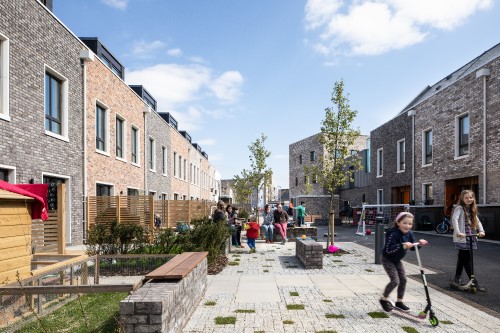Shared perspectives on cohousing – codesigning community
This Housing LIN blog by Jan Chadwick, K1 Cohousing, Marmalade Lane, Cambridge, and Meredith Bowles, Mole Architects share their views on codesigning community at this award winning development.
Jan writes…
Just 10 months on from move-in day, and we are already fulfilling our goal to be a successful, mutli-generation, multi-national Cohousing community/urban village.
A microcosm of Cambridge, our residents are a great bunch of people from a wide variety of backgrounds and experiences, contributing a richness to our life in cohousing - something our 20+ under 10 year olds will benefit from in the years to come.
The beautiful fabric of our build is complete, and we now have 33 resident households, with two more moving in soon - our community building is an ongoing activity. That's the joy of Cohousing!

Image: © David Butler
The design has fostered our social interaction. Our pedestrian lane, the creation of which was part of our original brief, is very much a play street with opportunities for young, and not so young, to play football together, roller blade, or just relax in our scattering of deck chairs and chat with the neighbours.
Building a community and looking after this "estate" is an ongoing job. We now have 14 working groups dealing with everything from kids to finance and all stops in-between. Our evolving communications, absolutely essential to Cohousing, are facilitated by Slack (a web-based tool), working groups and management council meetings but, more importantly, shared meals, impromptu gathering, BBQ's and street parties, as well as our monthly celebration socials and community arts and crafts - they're the glue that keep us together!
Life in Cohousing is an intense but enjoyable experience, not for the faint hearted, but definitely for those people who want to know and be social with their neighbours, take active interest and manage their own facilities and finances. Not for us the distant managing agents experienced by leaseholders. We are our own Residential Management company, comprising of all our household directors, making decisions by consensus, so no one gets left behind! It's not an easy process, and we are still learning and making mistakes along the way, but after these few short months we have "owned" our space like no other community. Quite a fete for the largest Cohousing build in the UK!
“Life in cohousing is an intense but enjoyable experience” Going forward, we still have a few houses for sale, and new families to integrate into our " village". We will continue to learn and evolve, and pass our experience on to others. Currently we're involved with the Community Council's working group for the Orchard Park area, have instigated monthly "rubbish rambles" around our locality, with the help of residents from the wider community, and we hosted a community art project on Environment Day this August. Integration is important to us - we are definitely not, and have no wish to be, a gated community.
An ongoing challenge is coping with our high profile. As a multi-award winning development, we are constantly asked to host visits from interested architects, developers, Cohousing groups, academics and, of course, we always meet and explain our community to potential buyers. Our dedicated Outreach Working Group tirelessly host groups and bake cake for our visitors. It's a joy to show off our buildings and gardens and hopefully stimulate a fresh look and new conversations about a different form of housing.
Meredith writes….
As an architect the experience of working to create 42 homes for a co-housing community has brought unexpected rewards. Architects working on housing projects tend to get fixated on what we build rather than who we build for. Community engagement is usually more about how a new development works within an existing community, rather than how the new houses are being designed in relation to the particularities of a group of people. We try to make good decisions from learning what has worked on other projects and hope that the new residents will agree.
Turning this on its head has been much easier than we feared. The group of residents at Marmalade Lane were pragmatic, well organised and good at decision-making. They were assisted in this process by a number of professionals: Adam Broadway of Instinctively Green, and Jim Ross from Cambridge Architectural Research helped to shape the group’s views into a brief on which the Council landowner could act. This then lead to a competitive tender which Mole won with TOWN and Trivselhus. Following this the final design was worked out with the future residents, with working groups on various aspects: the houses, the common house, the energy strategy, the landscape and so on. Options were presented and talked through to reach a consensus, eventually leading to a fixed design that went to a Design and Build tender.
Much of the challenge was around the difficulty in accommodating many different sizes and requirements for houses (initially everyone simply put down what they wanted, so very little repetition) into a form that could offer some formal coherence as well as being able to be delivered within a reasonable cost. We developed a model of custom build with TOWN that allowed for three different basic houses types (one a maisonette above a flat, to accommodate the smaller units needed) that would allow for maximum variation whilst keeping a simple terraced form. It is this that above all else characterises the scheme, and in many ways describes the attitude of the intention to build collectively; there is difference within a cohesive whole.
The unexpected aspect has come at the end, and increases as time goes by. I stop by now not to admire the architecture, as I might on other previous work, but to chat to people I’ve got to know well over the process of designing and building their homes.

Comments
Add your comment